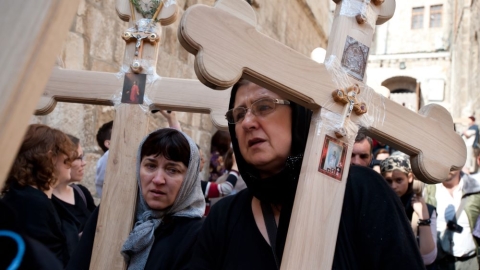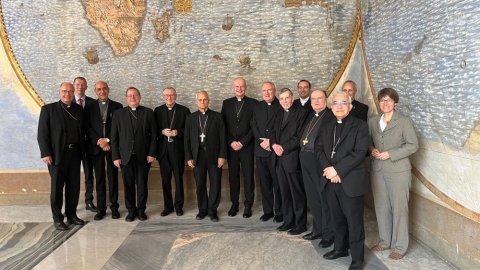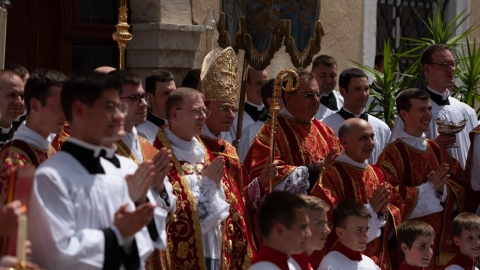The Second Death of St. Thomas More

Memorial floor plaque covering the relics of St. Thomas More
The relics of St. Thomas More are in danger. Resting for almost five centuries under a memorial floor plaque located in the church of Saint-Dunstan, United Kingdom, the state of deterioration is increasing. On the Anglican side, nothing is being done to preserve a heritage that recalls the dark aspects of a reform that separated England from Catholic unity.
St. Thomas More is one of the glories of English Catholicism: Lord-Chancellor of King Henry VIII, of whom he was for a long time one of the proteges, Sir Thomas was beheaded on July 6, 1535, owing to his refusal to take the Oath of Supremacy and swear allegiance to the monarch as the Supreme Governor of the Church of England, at the same time endorsing the king's divorce from Catherine of Aragon, and bringing the kingdom into schism.
His head “was placed on a spike on London Bridge where it remained for nearly a month” with the aim of discouraging those who would dare to defy the king, and “would have been thrown into the River Thames had Margaret Roper not intervened. Watching carefully and waiting for the opportunity, she bribed the executioner, whose office it was to remove the heads, and obtained possession of the sacred relic. There was no possibility of mistake, for she, with the help of others, had kept careful watch, and, moreover, there were signs so certain that anyone who had known him in life would have been able now to identify the head.”
“Once the head was safely in Canterbury where Margaret lived with her husband William Roper, it was preserved in a leaden casket, after which it became the possession of her eldest daughter, Elizabeth, Lady Bray. It was probably at her death in 1558 that it was placed in the Roper vault under the Chapel of St. Nicholas in St. Dunstan’s Canterbury.”
Beatified by Pope Leo XIII in 1886, Thomas More was canonized by Pope Pius XI in 1935, 400 years after his martyrdom, at the same time as St. John Fisher, Archbishop of Canterbury, who had also opposed the schism fomented by King Henry.
One important detail: St. Dunstan’s church is in the hands of the Anglicans, and the least we can say is that they have never really taken care of this relic which probably reminds them of the shaky foundation on which their religion rests.
Twice in fact, in 1978 and 1997, the head of the saint was exhumed on an ad hoc basis by scientists who were able to observe the worrying deterioration of the relic. For several years, American Catholic lawyer Steven Brizek has campaigned for its preservation. On June 22, 2023, he publicly sounded the alarm, because if nothing is done, the relic is destined to become irreparably corrupt, a form of “second death” for Thomas More.
“In recent years, those with the power to act in favor of the preservation of the relic have chosen the path of inaction: whether it is the product of willful negligence or indifference, it only served to accelerate its deterioration and diminish the hope of being able to preserve it,” warns the lawyer who calls on “all those who have the spirit and the intelligence to intervene to save the head of St. Thomas More.”
The Anglican clergy, for their part, procrastinate and defend themselves by claiming that “important work” has already been done on site in order to “highlight the figure of Thomas More.”
An attitude that surprises no one because, as Pope Pius XI recalls in the homily delivered on the occasion of the saint's canonization: “Thomas More knew, when he saw the purity of Christian doctrine exposed to serious dangers, to despise with energy the flattery of human respect, to resist the supreme head of the state, as his duty prescribed to him when it was necessary to obey God and the Church, and finally to renounce with dignity the high office which he was filling.”
Pius XI ended with an appeal full of faith and charity addressed to Anglicans, which has lost none of its topicality: “Let those who are still separated from Us consider attentively the ancient glories of their Church which reproduce and increase the very glories of the Roman Church; that they also consider and remember that this Apostolic See has been waiting for them so long, not as those who enter a foreign home, but as those who finally return to their own paternal home!”
The inscription on the gravestone reads: “Beneath this floor is the vault of the Roper family in which is interred the head of Sir Thomas More of illustrious memory sometime Lord Chancellor of England who was beheaded on Tower Hill 6th July 1535. Ecclesia Anglicana libera sit (let the Anglican Church be free).”
L’inscription sur la pierre tombale porte : « Sous ce sol se trouve le caveau de la famille Roper, dans lequel est enterrée la tête de Sir Thomas More, d’illustre mémoire, ancien Lord Chancelier d’Angleterre, qui fut décapité à la Tour de Londres le 6 juillet 1535. Que l’Eglise anglicane soit libre. »
Related links
(Sources : The National Catholic Register/Edward Pentin – FSSPX.Actualités)
Illlustration : Liondartois, CC BY-SA 3.0, via Wikimedia Commons





